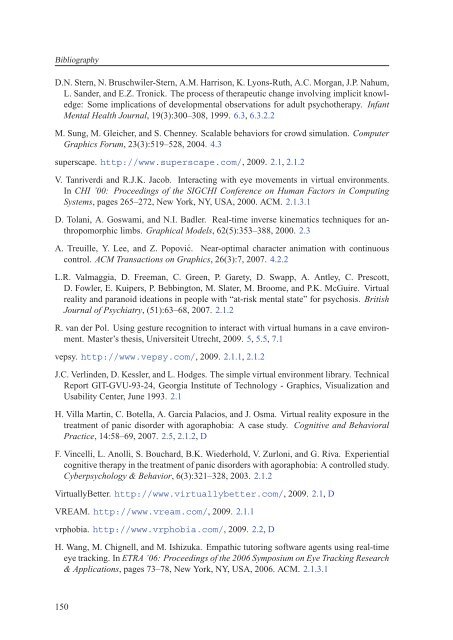Texte intégral / Full text (pdf, 20 MiB) - Infoscience - EPFL
Texte intégral / Full text (pdf, 20 MiB) - Infoscience - EPFL
Texte intégral / Full text (pdf, 20 MiB) - Infoscience - EPFL
Create successful ePaper yourself
Turn your PDF publications into a flip-book with our unique Google optimized e-Paper software.
Bibliography<br />
D.N. Stern, N. Bruschwiler-Stern, A.M. Harrison, K. Lyons-Ruth, A.C. Morgan, J.P. Nahum,<br />
L. Sander, and E.Z. Tronick. The process of therapeutic change involving implicit knowledge:<br />
Some implications of developmental observations for adult psychotherapy. Infant<br />
Mental Health Journal, 19(3):300–308, 1999. 6.3, 6.3.2.2<br />
M. Sung, M. Gleicher, and S. Chenney. Scalable behaviors for crowd simulation. Computer<br />
Graphics Forum, 23(3):519–528, <strong>20</strong>04. 4.3<br />
superscape. http://www.superscape.com/, <strong>20</strong>09. 2.1, 2.1.2<br />
V. Tanriverdi and R.J.K. Jacob. Interacting with eye movements in virtual environments.<br />
In CHI ’00: Proceedings of the SIGCHI Conference on Human Factors in Computing<br />
Systems, pages 265–272, New York, NY, USA, <strong>20</strong>00. ACM. 2.1.3.1<br />
D. Tolani, A. Goswami, and N.I. Badler. Real-time inverse kinematics techniques for anthropomorphic<br />
limbs. Graphical Models, 62(5):353–388, <strong>20</strong>00. 2.3<br />
A. Treuille, Y. Lee, and Z. Popović. Near-optimal character animation with continuous<br />
control. ACM Transactions on Graphics, 26(3):7, <strong>20</strong>07. 4.2.2<br />
L.R. Valmaggia, D. Freeman, C. Green, P. Garety, D. Swapp, A. Antley, C. Prescott,<br />
D. Fowler, E. Kuipers, P. Bebbington, M. Slater, M. Broome, and P.K. McGuire. Virtual<br />
reality and paranoid ideations in people with “at-risk mental state” for psychosis. British<br />
Journal of Psychiatry, (51):63–68, <strong>20</strong>07. 2.1.2<br />
R. van der Pol. Using gesture recognition to interact with virtual humans in a cave environment.<br />
Master’s thesis, Universiteit Utrecht, <strong>20</strong>09. 5, 5.5, 7.1<br />
vepsy. http://www.vepsy.com/, <strong>20</strong>09. 2.1.1, 2.1.2<br />
J.C. Verlinden, D. Kessler, and L. Hodges. The simple virtual environment library. Technical<br />
Report GIT-GVU-93-24, Georgia Institute of Technology - Graphics, Visualization and<br />
Usability Center, June 1993. 2.1<br />
H. Villa Martin, C. Botella, A. Garcia Palacios, and J. Osma. Virtual reality exposure in the<br />
treatment of panic disorder with agoraphobia: A case study. Cognitive and Behavioral<br />
Practice, 14:58–69, <strong>20</strong>07. 2.5, 2.1.2, D<br />
F. Vincelli, L. Anolli, S. Bouchard, B.K. Wiederhold, V. Zurloni, and G. Riva. Experiential<br />
cognitive therapy in the treatment of panic disorders with agoraphobia: A controlled study.<br />
Cyberpsychology & Behavior, 6(3):321–328, <strong>20</strong>03. 2.1.2<br />
VirtuallyBetter. http://www.virtuallybetter.com/, <strong>20</strong>09. 2.1, D<br />
VREAM. http://www.vream.com/, <strong>20</strong>09. 2.1.1<br />
vrphobia. http://www.vrphobia.com/, <strong>20</strong>09. 2.2, D<br />
H. Wang, M. Chignell, and M. Ishizuka. Empathic tutoring software agents using real-time<br />
eye tracking. In ETRA ’06: Proceedings of the <strong>20</strong>06 Symposium on Eye Tracking Research<br />
& Applications, pages 73–78, New York, NY, USA, <strong>20</strong>06. ACM. 2.1.3.1<br />
150

















